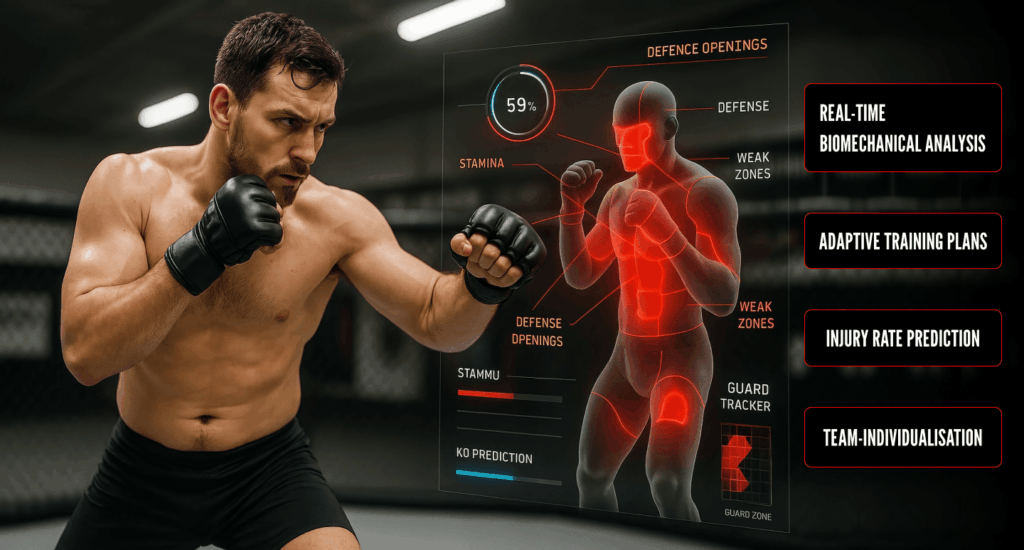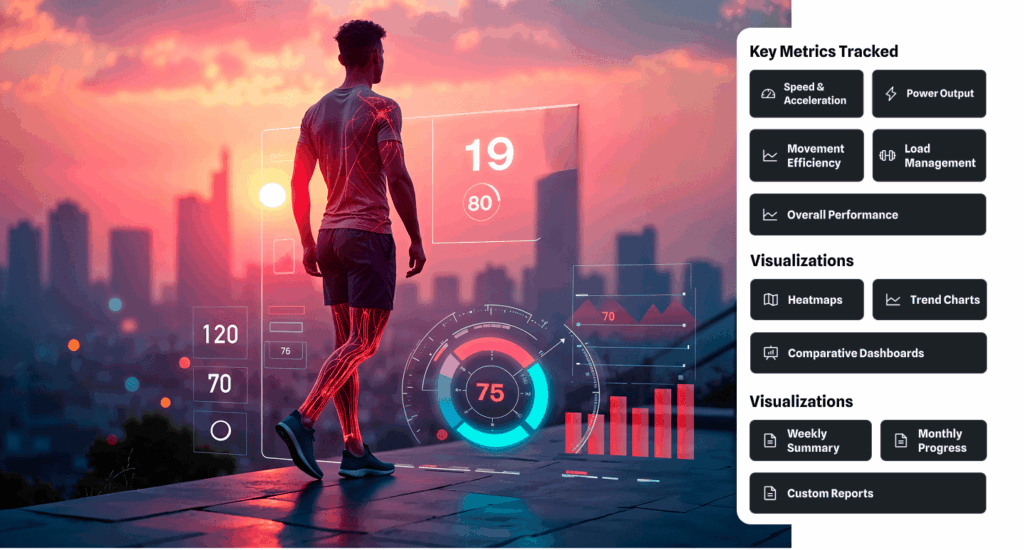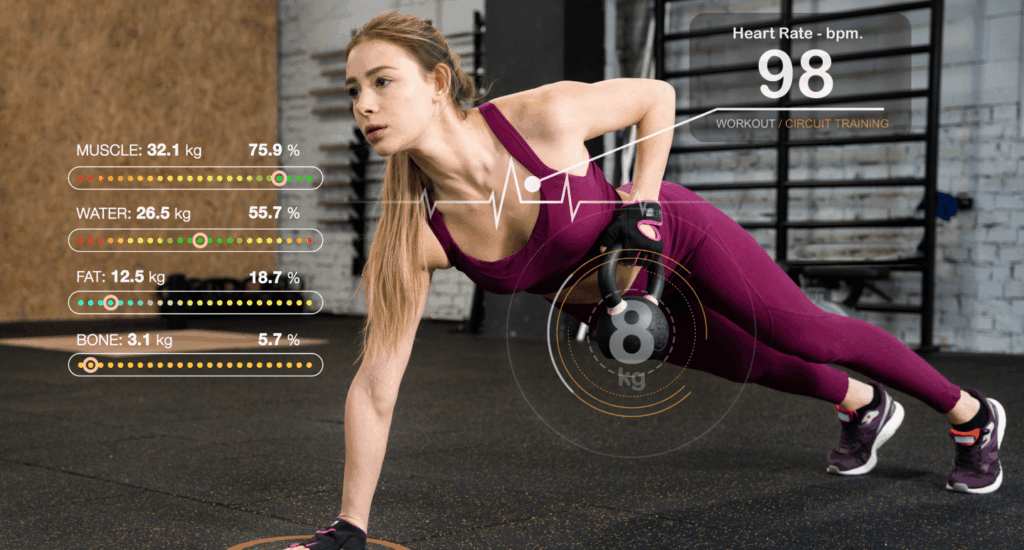|
Getting your Trinity Audio player ready...
|
Strategic Executive Overview & ROI Potential
The global sports industry is changing from how athletic performance was viewed to how it is being transformed by AI. Sports academies, organisations, and clubs are actively implementing AI-driven training coaches, not only as a cutting-edge technology paradigm in sports but also as a strategic investment. Athletes improve by 5 to 10% in productivity-based indicators such as speed, agility, endurance, and accuracy through the use of computer vision capabilities, predictive analytics, and tailored feedback systems.
The risk of injury due to overtraining is reduced by 30%, and, more importantly, the visibility coaches get on load management and fatigue levels of an athlete helps enhance this. Coaches also save a lot of their resources—giant cutbacks, usually between 20% and 25% by not requiring as many employees to perform manual checks on performance and doing a lot more through automation. Our product includes several features that distinguish it qualitatively from others: Proven history in the implementation of AI solutions for elite sports teams and fitness institutions that combine both technical innovation and sports utility. From pose estimations to real-time feedback loops, Esferasoft has led professional organisations to create new performance creams with reduced operational overhead. In 2025, AI isn’t just a luxury—it is an absolute must-have for competition, and Esferasoft’s AI Sports Coach guarantees measurable performance returns.
Differentiators & Competitive Advantages

And then there are intelligent, adaptive systems integrated with contextual awareness that enable their way from training as reactive to proactive.
Real-Time Biomechanical Analysis: The use of computer vision models, including CNNs and OpenPose, offers instantaneous feedback on form and technique to athletes. From a jump shot in basketball to a serve in tennis, poor biomechanics are detected and corrected in real-time through visual overlays and audio prompts, hastening skill acquisition and mitigating the chance of chronic injuries.
Adaptive Training Plans: Live metrics like heart rate variability, fatigue detection, sleep quality, and athlete goals enable the AI coach to adjust and appropriately time workouts rather than using a program that has defined workouts. The software enables athletes to train smarter rather than harder, depending on real recovery data and performance outputs.
Injury Rate Prediction: Predictive analytics tools show spikes in workloads, movement imbalances, and deviations in patterns of biometrics and flag high-risk cases for future injury. This shifts the role of sports science from a diagnostic approach to a preventive one.
Team-Individualisation: The AI Coach is not limited to singular athletes; however, it also accommodates the entire roster of a team. By deploying these solutions at scale, organisations can remotely monitor squads while providing highly personalised coaching.
These combined features give coaches and athletes AI-guided training that is both intelligent and practical, giving the Esferasoft platform an advantage over its competitors in very tough markets.
Core AI & Data Processing Modules

At the forefront of AI, the Sports Training Coach is designed for robust modular AI engines coupled with seamless data workflows to provide effective real-time analysis as well as long-term improvement in performance.
Data Sources:
Input streams come from a wide range of sources, such as high-definition video feeds from smartphones or fixed cameras, a host of wearable sensors like accelerometers, GPS, and IMUs, and biometric trackers with heart rate monitors or sleep bands. These diverse inputs are harmonised to paint the holistic or integrated architecture of athletic performance.
Model Types:
Pose Estimation Models: These include models such as OpenPose or custom CNN architectures for skeletal tracking, movement decomposition, and form correction.
Time-Series Analysis: This includes LSTM- and Transformer-based models that identify fatigue levels, trends in training load over time, and biomechanical consistency.
Training and Inference Pipelines:
The hybrid between cloud and edge is adopted herein, such that inference for real-time feedback is conducted on local edges (edge devices or smartphones) so that it has very minimal latency, while deeper trend analysis and retraining of models takes place on the cloud using scalable GPUs and advanced analytics engines.
Continuous Learning Loop:
Every training session feeds into a feedback loop. The model records anomalies, spikes in performance, and user interactions for later retraining. Over time, the AI becomes more efficient in identifying sport-specific movement patterns, thresholds for fatigue, and ideal loads for training.
This modularised AI will thus provide a platform that is responsive at the moment and smarter in time—not leaving coaches and athletes behind in their race for a continuously evolving training partner that adapts to goals and physiology.
Sensor & Device Integration Strategy
In-the-loop hardware integration into the AI ecosystem is what makes for excellent precision and reliability in all senses. Esferasoft’s strategy focuses on plug-and-play solutions, data flows synchronised with hardware usage, and an understanding of flexibility when using a training environment.
Wearable API Integration: The system is integrated with different standard Bluetooth Low Energy (BLE) and ANT+-compatible protocols that support the use of wearables like Polar, Garmin, and WHOOP-customised sensors. This will be ensured by a common SDK, which regulates uniform data formatting and packet access.
Camera Arrangement: The multi-angle camera setup enhances the effectiveness of biomechanical analysis. Calibration instruments will enable users to properly align cameras, even in ad hoc environments such as gyms or fields. The AI will then use synchronised feeds to triangulate movements in 3D spaces with greater accuracy.
Data Synchronisation: In ensuring coherence, all data streams are thus timestamp-aligned using an NTP protocol. A buffering mechanism smooths out spikes and irregular transmissions from edge devices, thereby safeguarding session data.
Offline vs. Live Mode: This platform can also work in both live feedback and offline analytics modes. It saves the collected data for later processing whenever there is low connectivity, and in the live mode, the inference made is almost instant, with feedback overlays and adjustments as they happen in the real world.
This versatility is what sets up a flexible integration framework to ensure that all devices and environments remain consistent in accurate data across all use cases.
Performance Analytics & Insights Dashboard

Esferasoft transforms raw data into actionable intelligence through an advanced analytics dashboard, customising it for both coaches and athletes.
Key metrics tracked include
- Speed & Acceleration: Monitor sprint bursts, average speeds, and quickness.
- Power Output: Assess force production in lifts, jumps, and swings.
- Movement efficiency: Analyse wasted motion and asymmetries while looking for mechanical bottlenecks.
- Load Management: Check on acute versus chronic workload ratios and recovery status.
Visualisations:
- Heatmaps: Movement patterns correlating with time and energy in a court or field.
- Trend Charts: Time-span graphs track improvements or regressions in key areas.
- Comparative Dashboards: Benchmark against teammates, previous sessions, or an optimal performance model.
Automated Reports:
- Session summaries at the end of workouts include highlights, anomalies, and indicators of progress.
- Coaches receive alerts for red flags—such as elevated injury risk or performance drops—along with suggested interventions.
This dashboard converts a complex dataset into easy-to-read visuals and proactive recommendations, thereby aiding the trainer in decision-making and empowering the athletes to self-correct and stay motivated.
UX/UI Considerations for Coaches & Athletes
Usability determines how well an AI system will perform. UI/UX designs from Esferasoft allow serving two core users—that is, coaches and athletes—without overwhelming either one of them.
Coadjutor Interfaces:
- Coach’s Dashboard: Simplistic yet rich data, comparison, and alerts delivered via the web or tablet access.
- Athlete Mobile View: A clean, yet intuitive mobile interface where personal metrics, goals, and feedback are reflected.
Real-Time Feedback Overlays:
Guiding athletes through drills, augmented with visual correction of form on-the-fly, will eliminate guesswork through real-time feedback overlays (via phone or AR glasses).
Customised Notifications:
- Athletes get nudges on recovery routines, milestone achievements, hydration, and stretch breaks.
- Meanwhile, for coaches, they receive push alerts when it comes to off-trend metrics or attendance issues.
Simplification of Work:
- Set up a typical session in no longer than 2 minutes. Tap to start, record, analyse, and finish.
- Sync among wearables and cameras occurs in the background.
The objective of totally frictionless designs is to maximise adoption by minimising unnecessary complexity. Be it a technically sound athlete or any long-suffering coach, this platform adapts to the user, not the other way around.
Pilot Program Framework & Proof of Concept
It is in areas such as those where holding a well-designed pilot program would go far in achieving a smooth uptake and very measurable outcomes. Along with this, Esferasoft provides a really robust pilot suite facility that can deliver value early and scale very efficiently.
Selecting the Pilot Group:
- The best pilot partners would include or be a professional sports team, an elite training academy, or a really top-notch fitness club. This would be a way to highlight advantages on a broad spectrum of high-performance and general fitness contexts.
Establishing Success Metrics:
- The metrics would include performance enhancement from 5% to 10%, reduction of injury flags by 30%, and satisfaction rates above 80% among users.
- Baseline Captures: Baseline assessments are done before the program’s pilot testing and benchmarked at the end of the pilot.
- Duration: The pilot is conducted over an 8-week period—one week of setup, four to six weeks of active use, and one week of reporting and feedback reviews.
Stakeholder Roles:
- The function of coaches is athlete interaction.
- Sports scientists ensure individuals will interpret data correctly in science.
- Staff in IT are responsible for integrating and fixing problems.
Scaling Plan:
- After the proof, Esferasoft gives the framework for rollout, including scaling in cloud infrastructure, training for staff, and onboarding modules.
The pilot program demonstrates the feasibility of the initiative, shows a return on investment (ROI), and builds trust in its readiness to be extended to all clubs, academies, and franchises.
Compliance, Safety & Ethical Guidelines
Artificial intelligence in sports needs to focus on safety, ethics, and data compliance for responsible usage.
Data Privacy:
- Esferasoft operates under strict compliance with GDPR and local data protection laws.
- Athletes’ biometric and performance data is encrypted, anonymised, and stored in a secure manner.
- Opt-in/opt-out options are available for the users to decide whether to share their data.
Safety Protocols:
- Immediate feedback is provided in a manner that assists, never overrides, human reasoning.
- The system notifies you of high-risk movements to ensure safe training intensities.
- Coaches are alerted if their athletes ignore warnings.
Ethical Use:
- Transparency is key; AI suggestions show reasoning (for example, “form deviation of 12% from baseline”).
- Esferasoft monitors its datasets and models for fairness in recommendations by examining race, gender, or biomechanics biases.
As AI becomes a co-pilot in athletic training, it must adhere to the same ethical standards as human coaching. The same commitment to ethical AI by Esferasoft ensures the trust of its users, institutions, and regulatory bodies.
Business Models & Monetisation Strategies
AI Sports Coach offers flexible monetisation options for clubs, leagues, and fitness chains of various sizes, from small to large.
Subscription Tiers:
- Individual Tier: For individual athletes or personal trainers.
- Team Tier: For small teams and medium-sized teams, providing dashboard access to coaches.
- Enterprise License: For clubs, leagues, or federations that require a customised solution that supports multiple locations.
Usage-Based Pricing:
Organisations may choose to use pay-as-you-go billing based on the number of sessions, hours of video processing, or cloud compute time. This pricing model is ideal for seasonal users or for event-based deployments.
Value Addition Services:
- We offer data science packages tailored to your needs, custom dashboards, and integrated consulting support from sports scientists and AI experts.
- Additional services include form-specific training plans, branded athlete reports, and white-glove support.
White-Label Solutions:
- Partner with sports academies or OEMs to create co-branded versions of the platform.
- This model is perfect for equipment manufacturers wanting to bundle a digital training companion with their gear.
This varied business model guarantees income continuity and flexibility while placing maximum value on partners.
Cost Breakdown & Investment Considerations
The budget must be transparent to obtain approval from stakeholders. Esferasoft creates detailed estimates depending on deployment scale and technical scope.
MVP Budget: $80K-$120K
- The budget includes one sport wearable, basic pose detection (using, for example, OpenPose), a web/mobile data dashboard, and integration with a single sensor type (for example, GPS or heart-rate monitor).
- The product is primarily intended for academies or fitness startups that are just starting out.
Full Solution Budget: $250K-$500K
- Multi-sensor fusion (GPS+IMU+heart rate), AR feedback, fatigue detection algorithms, and predictive analytics.
- This solution is more tailored for professional or national clubs that have long-term transformation aspirations.
Cost Variables:
- Sports Type: Team vs. individual sports have different needs for sensors and workflows.
- Sensor Complexity: More sensors = higher integration costs.
- Edge vs. Cloud: Real-time feedback at the edge is more expensive upfront but saves on ongoing cloud bills.
Ongoing Costs:
- The monthly costs for cloud inference range from $1,000 to $5,000, depending on the volume of usage.
- Model retraining, software updates, and support retainer ($2K-$10K/month).
With its modular packages and clear ROI predictions, Esferasoft brings predictability to the budget. If you’re going into a pilot project phase or a full digital transformation, we will create your investment plan with your specific objectives in mind.
Why Esferasoft? Expertise in AI Sports Solutions
Esferasoft has now positioned itself at the core of sports science and AI engineering with a strong history of bringing highly transformative outcomes, whether in working with clients in sports science or in AI engineering.
Our state-of-the-art systems portfolio includes AI-based training systems for Olympic-level athletes, football federations, and performance gyms. Our in-house team consists of deep learning experts, sports scientists, and human movement specialists, all dedicated to ensuring that every feature of the program helps athletes perform better in real life.
From integration of hardware to edge computing, model training, and performance analytics dashboards, we do it all. Unlike some small niche providers or fragmented solutions, Esferasoft provides a complete, integrated program supervised under an SLA and delivered with white-glove service.
With proven case studies, enterprise-grade reliability, and a collaborative spirit, Esferasoft emerges as the ideal partner for any future technology in sports performance.
Take the Next Step: Transform Your Sports Training with AI

Ready to transform your training programs? Join Esferasoft for a complimentary performance assessment workshop specific to your sport and team size. Learn how AI can help release the true potential of your athletes so you can spend less time and money on coaching. Contact us now at +91 772-3000-038
Limited slots are available for the pilot program of Q3 2025, so grab your opportunity now. Schedule your discovery call today to design a tailored roadmap, custom ROI estimates, and a real prototype demo.
AI is not the future—it’s the present. Train smart, recover wisely, and win more—with you!

